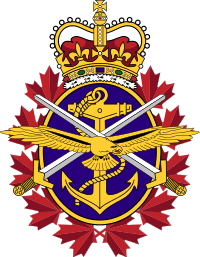The Canadian Armed Forces (CAF; French: Forces armées canadiennes, FAC) are the unified military forces of Canada, including land, sea, and air commands referred to as the Canadian Army, Royal Canadian Navy and the Royal Canadian Air Force.[9] The CAF also operates several other commands, including the Canadian Forces Intelligence Command, the Canadian Joint Operations Command, and the Canadian Special Operations Forces Command. Personnel may belong to either the Regular Force or the Reserve Force, which has four sub-components: the Primary Reserve, Supplementary Reserve, Cadet Organizations Administration and Training Service, and the Canadian Rangers. Under the National Defence Act, the Canadian Armed Forces are an entity separate and distinct from the Department of National Defence (the federal government department responsible for the administration and formation of defence policy), which also exists as the civilian support system for the forces.[10][11][12]
The commander-in-chief of the Canadian Armed Forces is constitutionally vested in the monarch, Charles III.[13][14][15] The chief of the Defence Staff is the professional head of the Canadian Armed Forces, who under the direction of the minister of national defence and together with the assistance of the Armed Forces Council, manages the operations of the Canadian Armed Forces.
In 2023, Canada's military expenditure totalled approximately US$27.2 billion, or around 1.3 percent of the country's gross domestic product (GDP) — placing it 16th for military expenditure by country.[5] The Canadian Armed Forces are a professional volunteer force that consists of approximately 68,000 active personnel and 27,000 reserve personnel, with a sub-component of approximately 5,000 Canadian Rangers.[3]
Canada's peacekeeping role during the 20th century has played a major role in its positive global image.[16][17] Canada has long been reluctant to participate in military operations that are not sanctioned by the United Nations (UN),[18][19] such as the Vietnam War or the 2003 invasion of Iraq.[18][19] Since the 21st century, Canadian direct participation in UN peacekeeping efforts greatly declined, with its military participation reallocated to UN-sanctioned operations through the North Atlantic Treaty Organization (NATO).[20]
- ^ "Registration of a Badge". Public Register of Arms, Flags and Badges of Canada. Official website of the Governor General. Retrieved 8 November 2021.
- ^ "'Prime Minister Trudeau is shuffling his cabinet today. Here's what we know". CBC News. 26 July 2023. Retrieved 26 July 2023.
- ^ a b c "Canadian Armed Forces 101". National Defence. Government of Canada. 11 March 2021.
- ^ "Current operations list". Government of Canada. 27 March 2013. Retrieved 24 September 2020.
- ^ a b c "Trends in World Military Expenditure, 2023" (PDF). Stockholm International Peace Research Institute. April 2024. Retrieved 5 June 2024.
- ^ Canadian Defence Review Canada's 2011 Top 50 Defence Companies Archived 31 March 2012 at the Wayback Machine. Retrieved on: 15 December 2011
- ^ Canadian Defence Review Canada's 2011 Top 50 Defence Companies Archived 31 March 2012 at the Wayback Machine. Retrieved on: 28 August 2011
- ^ "The World Factbook > Canada > Military". Central Intelligence Agency. 19 November 2015. Retrieved 23 November 2015.
- ^ "National Defence". Government of Canada. Retrieved 11 September 2023.
- ^ "Frequently Asked Questions – What is the relationship between DND and the CAF?". Department of National Defence. 27 July 2013. Retrieved 11 April 2014.
- ^ "About the Canadian Armed Forces". Her Majesty the Queen in Right of Canada. 27 July 2013. Archived from the original on 17 March 2015. Retrieved 3 April 2015.
- ^ "About the Department of National Defence and the Canadian Armed Forces – National Defence Act". Her Majesty the Queen in Right of Canada. 23 May 2013. Retrieved 3 April 2015.
- ^ Victoria (29 March 1867). Constitution Act, 1867. III.15. Westminster: Queen's Printer. Retrieved 15 January 2009.
- ^ Lagassé, Philippe (December 2013). "The Crown's Powers of Commander-in Chief: Interpreting Section 15 of Canada's Constitution Act, 1867" (PDF). Review of Constitutional Studies. 18 (2): 189–220. Archived from the original (PDF) on 4 March 2016. Retrieved 10 November 2015.
- ^ "Governor General of Canada > Commander-in-Chief". Rideau Hall. Archived from the original on 1 December 2007. Retrieved 15 January 2009.
- ^ Sorenson, David S.; Wood, Pia Christina (2005). The Politics of Peacekeeping in the Post-cold War Era. Psychology Press. p. 158. ISBN 978-0-7146-8488-8.
- ^ Sobel, Richard; Shiraev, Eric; Shapiro, Robert (2002). International Public Opinion and the Bosnia Crisis. Lexington Books. p. 21. ISBN 978-0-7391-0480-4.
- ^ a b Massie, Justin (30 April 2019). "Why Canada Goes to War: Explaining Combat Participation in US-led Coalitions". Canadian Journal of Political Science. 52 (3). Cambridge University Press (CUP): 575–594. doi:10.1017/s0008423919000040. ISSN 0008-4239.
- ^ a b Mingst, K.; Karns, M.P. (2019). The United Nations In The Post-cold War Era, Second Edition. Taylor & Francis. p. 63. ISBN 978-1-000-30674-3.
- ^ Linda McQuaig (2010). Holding the Bully's Coat: Canada and the U.S. Empire. Random House Digital. p. 50. ISBN 978-0-385-67297-9.
Cite error: There are <ref group=lower-alpha> tags or {{efn}} templates on this page, but the references will not show without a {{reflist|group=lower-alpha}} template or {{notelist}} template (see the help page).

